Recycling in Savannah
How to Motivate People to Create Better Recycling Habits through Awareness, Education and Convenience
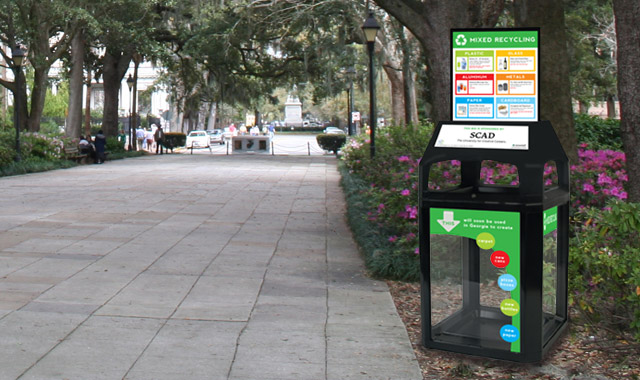
Overview
For my final project in the Design Management program at SCAD, I wanted to take a closer look at recycling in Savannah, GA. The purpose of my study was to reveal a better way to encourage and enable recycling for Savannah residents, making it a habitual part of everyday life.
The first thing I did was to research the current state of recycling in Savannah. I then needed to learn what motivates people to change their habits. From this research, I discovered opportunities the City of Savannah may have to increase recycling efforts by implementing a new strategy and visual campaign.
After sending my research findings to the City of Savannah’s Recycling Coordinator, I was asked to join their board. Since I no longer live in Savannah, I was unfortunately unable to take up the position, but I continue to consult with the Recycling Coordinator through email and phone correspondence as the city expands recycling efforts.
The following is an overview of my research, the opportunities I found, and the design solutions that met these needs. If you want to learn even more, you can scroll to the bottom of this page and flip through my entire process book.
Opportunity
Savannah recently introduced single-stream curbside recycling to city residents in January 2009. However, with participation rates at 40%, that still leaves room for 60% of the population to be motivated to join the effort. There is also the opportunity to expand recycling to public spaces, such as squares and parks.
In addition to the many environmental benefits of recycling, recycled materials are also valuable commodities that provide economic opportunities for new and existing markets. There is already a strong market for recyclable materials in Georgia, with more than 900 recycling-related companies in the state.
Even with the local market demand for recyclable materials, it is estimated that each year the state of Georgia spends $1 million to throw away $3 million worth of recyclables. Approximately 36% of municipal solid waste disposed of in GA is composed of commonly recycled materials. If cities like Savannah could prevent more of these recyclables from ending up in the landfill, local economies would directly benefit from both a reduction in waste disposal costs and the growth of businesses that depend on these recovered commodities.
Objectives
Methodology
My strategy and accompanying visual campaign offers a unique approach to encouraging and enabling increased recycling in Savannah, GA. Government, individuals, and businesses have the opportunity to work together to create sustainable habits. Unlike traditional campaigns intended to simply raise awareness about the environmental importance of recycling, this strategy focuses on creating a path for lasting change. This path for change is created by addressing the rational and emotional sides of people as well as the environments in which we work and live.
This methodology is based on principles from the book SWITCH: How to Change Things When Change is Hard by Chip Heath & Dan Heath.
Research
I started off with background research, looking at the current state of recycling in Savannah and Georgia as well as analyzing the Georgia Recycling Campaign. I then moved on to contextual research, which included park observations, an online survey, interviews with Savannah Residents, the creation of user personas, and an interview with Nathaniel Glover, City of Savannah Recycling Coordinator.
Recycling Strategy
Recycling at Home
After speaking with Nathaniel Glover, the city’s Recycling Coordinator, I learned that the city is planning to implement an incentive program in July in order to reward those who are participating in the program. This is a great way to add positive reinforcement to the current system in order to encourage the initial change as it slowly becomes a habit. A second incentive-based approach could be a partnership with RecycleBank. With this incentive system, everyone who recycles can get rewards rather than just a few randomly selected participants.
One other thing the city can do when the incentive program begins is to mail out a progress report to show citizens how far the city has come in its recycling efforts in the past two years. This will keep a solutions focus on recycling rather than a problems focus, and it shrinks the change while also providing clarity. Once Savannah residents become more familiar with recycling, the city can switch to a pay-as-you-throw trash system. This type of system encourages people to recycle more than they throw away, as well as find other ways to cut down on waste in order to reduce how many bags of trash they create.
Recycling Away from Home
The more a person is exposed to something, the more they will like it. In order to rally the herd and capitalize on this “mere exposure effect” we must have more recycling bins in public places. This will help make recycling as routine as throwing items in the trash. Currently, the City of Savannah has no plans for placing recycle bins in public areas because all the money has been used up from the grant they received for curbside recycling. Also, they are concerned that people will accidentally contaminate the bins due to lack of knowledge or awareness about recycling.
One way the City can cover the cost of bins and the hauling of materials is by creating a program where businesses and private citizens can pay to sponsor or adopt recycling bins. This can either be done by a flat fee up front or by a yearly fee. The sponsor name or logo will appear on the bin. Sponsors will also receive stickers that they can place on a window or wherever they like to show that they are supporting the City’s recycling efforts. This plan allows for the City of Savannah to work together with businesses and private citizens to create a path for change.
This strategy has the potential to improve the rational, emotional and environmental factors affecting a person’s decision to recycle. We will be creating a shared identity for residents of Savannah, where the community can come together for a local cause, both by recycling and by supporting those who adopt recycling bins. We can also add incentives to this outdoor recycling strategy by placing the RecycleBank logo and a unique reward code on each bin. This will encourage more people to recycle since they can earn points towards rewards online from RecycleBank every time they go to a new bin.
The plan I developed has four phases, starting with the launch of a website and 20 sponsored bins placed in Forsyth Park. The bins will be monitored for contamination, and the amount of recyclables collected will be tracked. If phase one is successful, the city can move on to the other phases.
Business Model Canvas
A business model describes the rationale of how an organization creates, delivers, and captures value. This business model serves as a blueprint for the new away-from-home recycling strategy.
Visual Strategy
Consistent Visuals
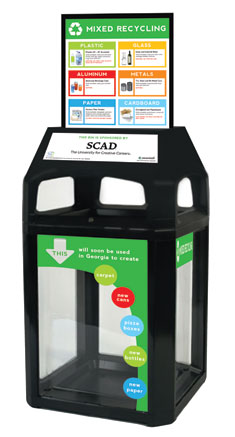
In order to increase recycling participation rates, the City of Savannah must bring more clarity and transparency to the recycling process through consistent graphics across all platforms. This will strengthen the overall message and strategy.These visuals will need to be present on all the materials in the recycling education complex, the City of Savannah recycling website and on all recycling bins. My proposed visual strategy includes a four-pronged approach aimed at providing clarity, transparency, value and visibility.
Recycling Bin Graphics
This is a design concept for the recycling bin to be used as part of the Adopt-A-Bin program. The transparent bin will reduce the risk of accidental contamination because people will be able to clearly see that this is not a trash can. This new recycling bin will attract attention with bright colors and interesting graphics. The placement of the top graphics on the bin are closer to eye level in order for people to easily read the instructions. The bottom section of the bin will show what the collected recyclables can be used to create locally in Georgia. This will form an emotional connection between people and the cause.
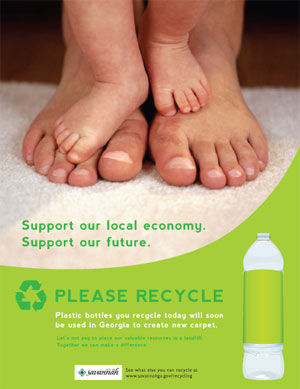
Campaign Visuals
The following visuals were created to serve as a framework for a potential new recycling campaign. This campaign will focus on creating an emotional attachment between Savannah citizens and the cause. There will be an emphasis on the ability to make a big impact locally through small changes in habit. The focus will be on value and how it is a waste to send our resources to a landfill. The graphics will include the color coding from the bin visuals that match up with the material category the advertisement is referencing. The photos used should always show people, and it is even better if the people shown can be multi-generational in order to represent the future of Savannah.
Visuals Test
A visuals test was conducted in order to see if the new graphics are clearly communicating what can and cannot be recycled in the City of Savannah. This testing is important in order to ensure that the graphics will be effective in preventing contamination. Participants were asked to sort a bin full of items into groups for what can and cannot be recycled, based on the graphics they were shown.
For the most part, participants sorted all the items correctly after being shown the new graphics. However, there was some confusion about what wax-coated cardboard is and whether or not a milk carton can be recycled. This means it may be beneficial to put “milk carton” as an example in the “do not” section for cardboard.
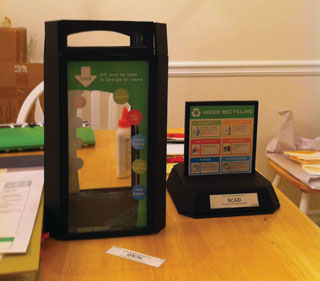
Next Steps
Further Testing and Prototype Development
Although some initial testing and prototyping was completed with the new bin design and graphics, more contextual research must be done in order to ensure clarity of communications. We want to make certain that contaminants will not accidentally make it into a bin because the graphics are not clear to everyone.
The City of Savannah is considering using parts of my strategy as they move forward with involving businesses in recycling efforts. I continue to consult with the Recycling Board, and I am trying to create more opportunities for other SCAD students to work with the City of Savannah so they can make a difference in the community.
For more information, please feel free to flip through my process book:
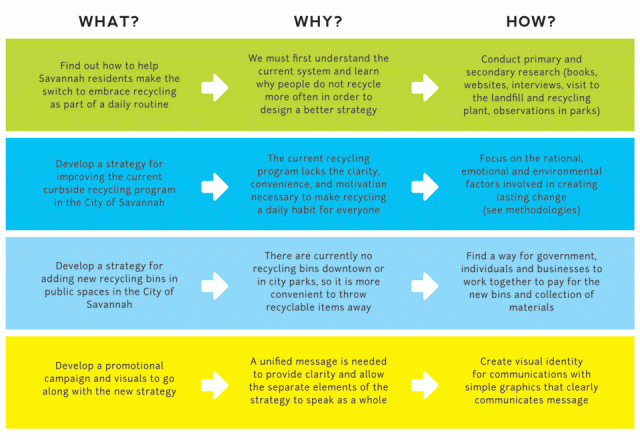
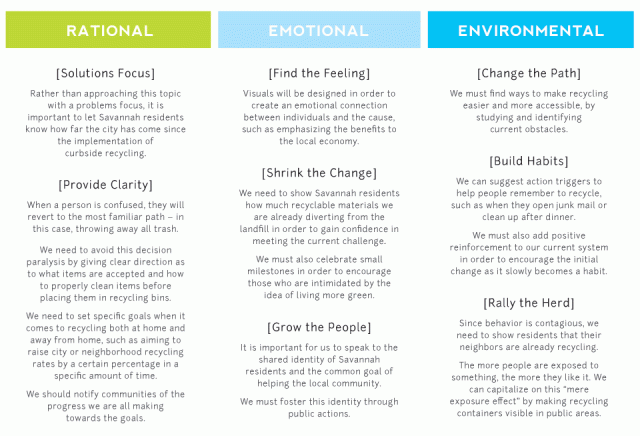
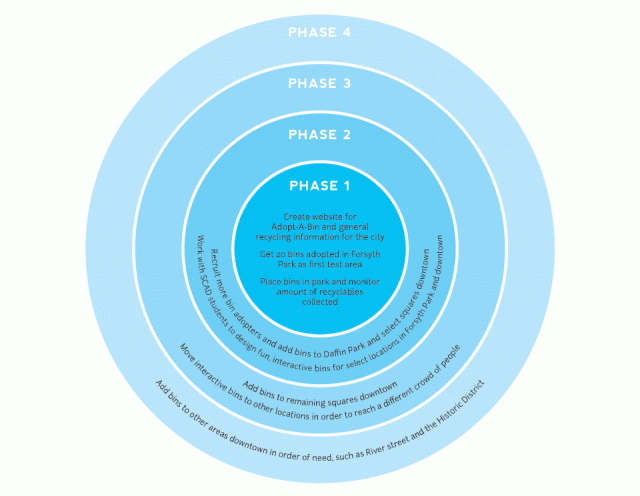
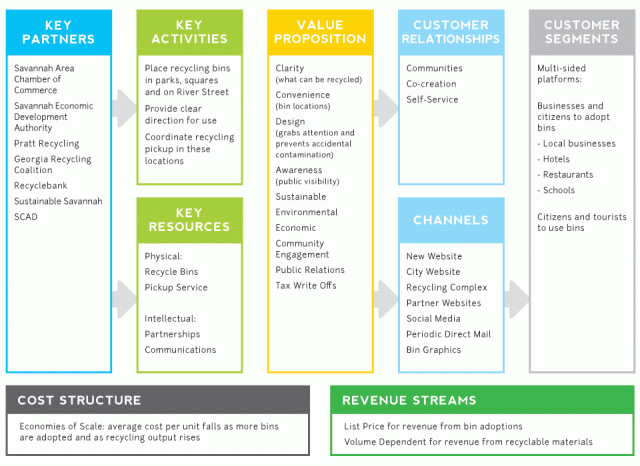

Related posts:
Comments
2 Responses to “Recycling in Savannah”
Trackbacks
Check out what others are saying...[…] many plants can only recycle certain plastics, people are often confused about what they can and can’t recycle. Hopefully this technology will eventually help to recover and recycle more plastics around the […]
[…] Infographic: Why Don’t Americans Recycle?.Just half of Americans recycle daily, and 13 percent don’t recycle at all. Most people recognize the benefits of recycling, but they’re often not sure which items can be recycled and find the process inconvenient and time-consuming (a topic of personal interest to me). […]